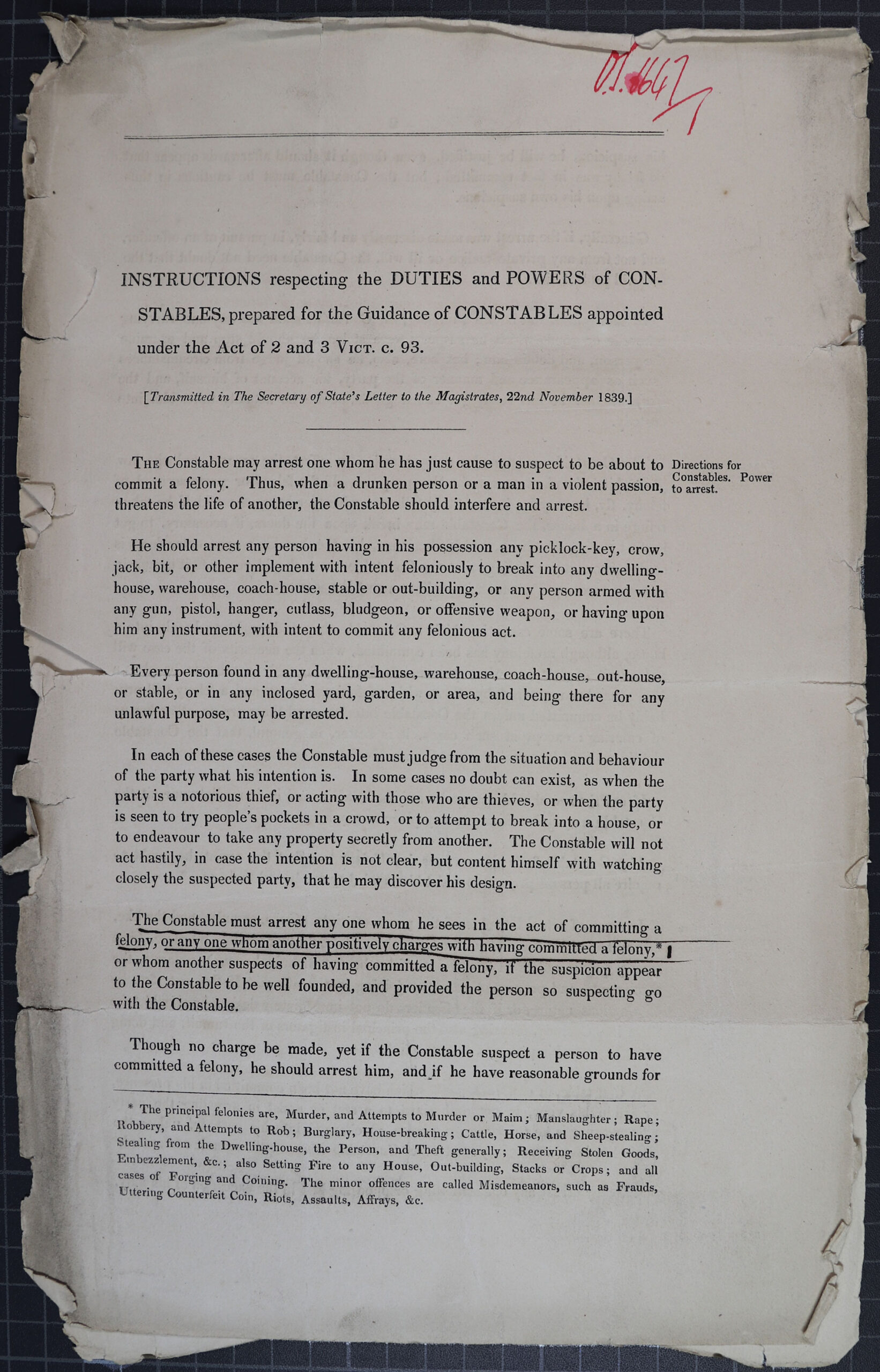
‘Instructions respecting the Duties and Powers of Constables’, 1839. Catalogue Ref. HO 45/6647
This was one of the first attempts to describe the powers of a police constable.
Transcript
Instructions respecting the duties and powers of Constables, prepared for the Guidance of Constables appointed under the Act of 2 and 3 Vict. [Victoria] C.93.
[Transmitted in The Secretary of State’s Letter to the Magistrates, 22nd November 1839.]
The Constable may arrest one whom he has just cause to suspect to be about to commit a felony. Thus, when a drunken person or a man in a violent passion, threatens the life of another, the Constable should interfere and arrest.
He should arrest any person having in his possession any picklock-key, crow, jack, bit, or other implement with intent feloniously [illegally] to break into any dwelling-house, warehouse, coach-house, table or out-building, or any person armed with any gun, pistol, hanger [small sword], cutlass [short curved sword], bludgeon [heavy stick], or offensive weapon, or having upon him any instrument, with intent to commit any felonious act.
Every person found in any dwelling-house, warehouse, coach-house, out-house, or stable, or in any enclosed yard, garden, or area, and being there for any unlawful purpose, may be arrested.
In each of these cases the Constable must judge from the situation and behaviour of the party what his intention is. In some cases, no doubt can exist, as when the party is a notorious [infamous] thief, or acting with those who are thieves, or when the party is seen to try people’s pockets in a crowd, or to attempt to break into a house, or to endeavour to take any property secretly from another. The Constable will not act hastily, in case the intention is not clear, but content himself with watching closely the suspected party, that he may discover his design.
The Constable must arrest anyone whom he sees in the act of committing a felony*, or any one whom another positively charges with having committed a felony, or whom another suspects of having committed a felony, if the suspicion appear to the Constable to be well founded, and provided the person so suspecting go with the Constable.
Though no charge be made, yet if the Constable suspect a person to have committed a felony, he should arrest him, and if he have reasonable ground for …
*The principal felonies are, Murder, and Attempts to Murder or Maim; Manslaughter; Rape; Robbery; and attempts to Rob; Burglary, House-breaking; Cattle, Horse and sheep-stealing; Stealing from dwelling-house, the Person and Theft generally; Receiving Stollen Goods; Embezzlement*, Etc., also setting Fire to any House, Out-building, Stacks or Crops; and all cases of Forging and Coining. The minor offences are called Misdemeanors, such as Frauds, Uttering Conterfeit Coins [creating fake coinage] , Riots, Assaults, Affrays [brawls]. Etc.
Glossary for starred* words, other word meanings given in brackets.
- The term ‘felony’ is defined in the document itself and provided at the end.
- Embezzlement*: theft or misappropriation of funds placed in one’s trust or belonging to one’s employer.
- What powers were police constables given according to this document?
- How does this compare to police powers today?
- ‘In each of these cases the Constable must judge from the situation and behaviour of the party what his intention is’. Can you see any potential problems in leaving decisions to the constable’s judgement?
- What information can be inferred from this document about the social conditions of London in the early-mid nineteenth century?
- What crimes were commonly committed at the time?
- What are the differences with crimes committed today?
